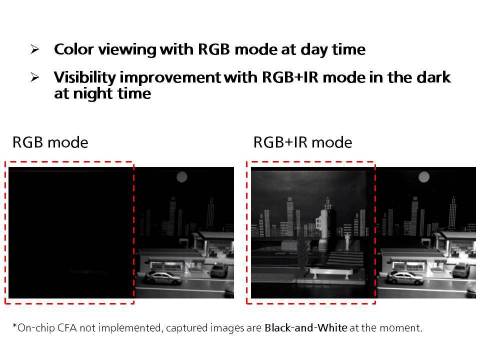OSAKA, Japan--(BUSINESS WIRE)--Panasonic Corporation today announced that it has developed a new technology, electrical control of the near infrared (NIR) light sensitivity of the same pixel in an organic CMOS image sensor. The sensitivity of all the pixels in the image sensor, which has directly stacked organic films, is simultaneously controlled by changing the applied voltage to the organic films.
This technology enables to switch between modes of color imaging*2 and NIR imaging frame by frame without a mechanical IR cut filter required for conventional image sensors. This contributes to miniaturizing a camera system and improving the robustness. This technology also enables global shutter operation*3 . Therefore, it can be suitable for applications in various fields of industry such as machine vision or intelligent transportation system, in which fast and accurate inspection or recognition are necessary.
The new technology has the following advantage.
Frame by
frame switching between color imaging mode and NIR imaging mode without
the loss of resolution.
The development is based on the following technologies.
- The design technology of organic CMOS image sensors which enables to design the photoelectric conversion part and the readout circuit part independently.
- The sensitivity control technology which enables frame by frame switching between color imaging mode and NIR imaging mode by changing the applied voltage to the photoelectric conversion part.
Panasonic holds 94 Japanese patents and 68 overseas patents (including pending) related to these technologies.
Panasonic will present some part of these technologies at the international academic conference: ISSCC (International Solid-State Circuit Conference) 2017 which is to be held in San Francisco on February 5 - February 9, 2017.
Notes:.
*1: As of February 9, 2017, according to Panasonic
data.
*2: The extinction ratio of NIR sensitivity at 800 nm was -28
dB.
*3: Previous report in ISSCC2016, http://news.panasonic.com/global/press/data/2016/02/en160203-6/en160203-6.html
More on the Technologies
-
The organic CMOS Image Sensor Design Technology, in that,
photoelectric conversion part and the readout circuit part can be
designed independently.
In the organic CMOS image sensor, photoelectric conversion is executed by an organic film while signal charge accumulation and the signal readout are executed by Si based circuits beneath the organic film. The film and the circuits can be designed independently, so the organic CMOS image sensor can achieve the following features: high sensitivity, wide-dynamic range, and global shutter function. The newly developed technology has been realized to extend the spectral sensitivity of the image sensor from visible light spectrum to near infrared (NIR) light spectrum. And also, it makes possible to control the NIR light sensitivity electrically without losing the unique features of organic CMOS image sensors as described above. -
The Sensitivity Control Technology, in that, frame by frame
switching between color imaging and NIR imaging can be realized by
changing the applied voltage to the organic layer.
The spectral sensitivity of an organic CMOS image sensor can be extended from visible light spectrum to NIR light spectrum by stacking two organic layers, one of which can absorb visible light and the other of which can absorb NIR light. However, just simply stacking or mixing those two layers does not allow to distinguish the NIR light signal from visible light signal. In order to distinguish those signals, conventional methods need extra components such as electrodes and thin-film transistors, that results in increasing the pixel size.
To solve this problem, we adopted the direct stacked structure of two organic layers with the high resistance ratio of those. In this structure, the applied voltage is distributed to those two layers unequally. In other words, relatively low voltage is applied to one organic layer while relatively high voltage is applied to the other layer using the same voltage source. Organic CMOS image sensors need to be applied the voltage at least higher than a threshold in order to get signal information from incident light. Due to the characteristic, it is realized by the structure that both of those layers have no sensitivity at the low voltage, only one layer has sensitivity at the middle voltage, and both of those layers have sensitivity at the high voltage. Namely, this structure enables electrical switching of color imaging mode, in which the sensor is sensitive only to visible light and NIR imaging mode, in which the sensor is sensitive to visible light and NIR light without increasing any component.
About Panasonic
Panasonic
Corporation is a worldwide leader in the development of diverse
electronics technologies and solutions for customers in the consumer
electronics, housing, automotive, enterprise solutions and device
industries. Since its founding in 1918, the company has expanded
globally and now operates 474 subsidiaries and 94 associated companies
worldwide, recording consolidated net sales of 7.553 trillion yen for
the year ended March 31, 2016. Committed to pursuing new value through
innovation across divisional lines, the company uses its technologies to
create a better life and a better world for its customers. To learn more
about Panasonic: http://www.panasonic.com/global.





